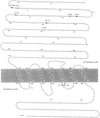Abstract
We report five novel mutations in the human Ca2+-sensing-receptor gene that cause familial hypocalciuric hypercalcemia (FHH) or neonatal severe hyperparathyroidism. Each gene defect is a missense mutation (228Arg→Gln, 139Thr→Met, 144Gly→Glu, 63Arg→Met, and 67Arg→Cys) that encodes a nonconservative amino acid alteration. These mutations are each predicted to be in the Ca2+-sensing receptor's large extracellular domain. In three families with FHH linked to the Ca2+-sensing-receptor gene on chromosome 3 and in unrelated individuals probands with FHH, mutations were not detected in protein-coding sequences. On the basis of these data and previous analyses, we suggest that there are a wide range of mutations that cause FHH. Mutations that perturb the structure and function of the extracellular or transmembrane domains of the receptor and those that affect noncoding sequences of the Ca2+-sensing-receptor gene can cause FHH.
Full text
PDF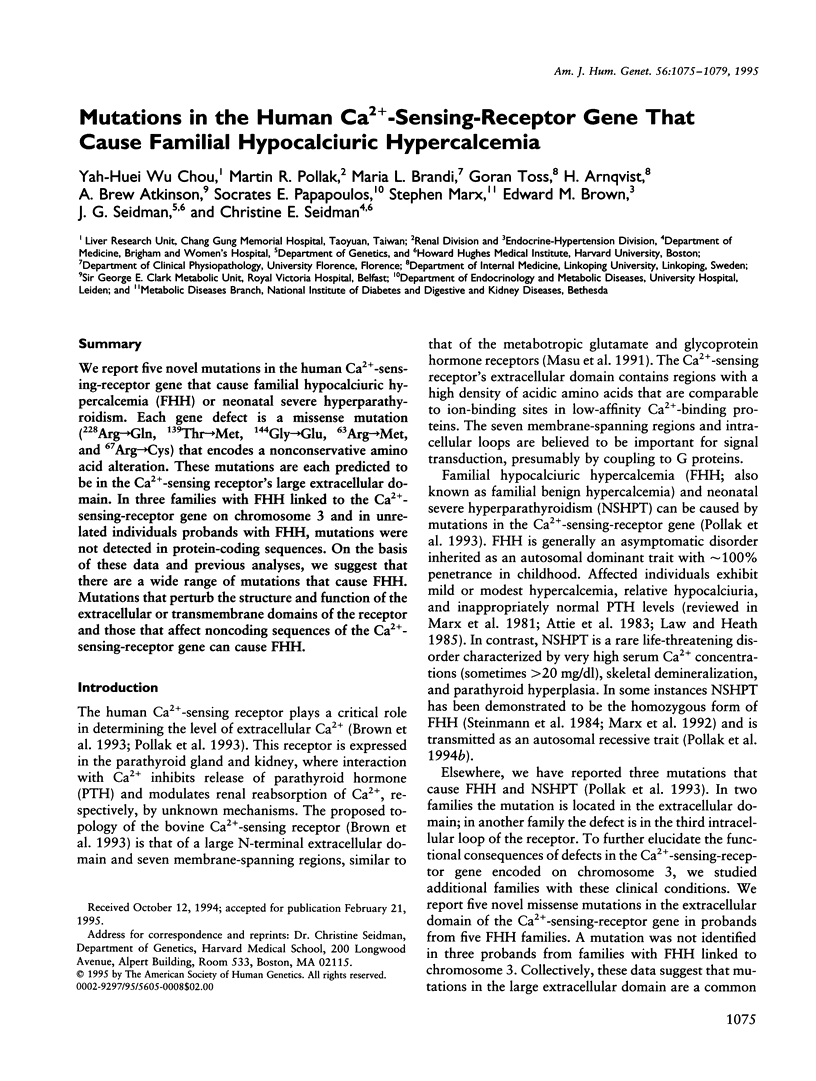
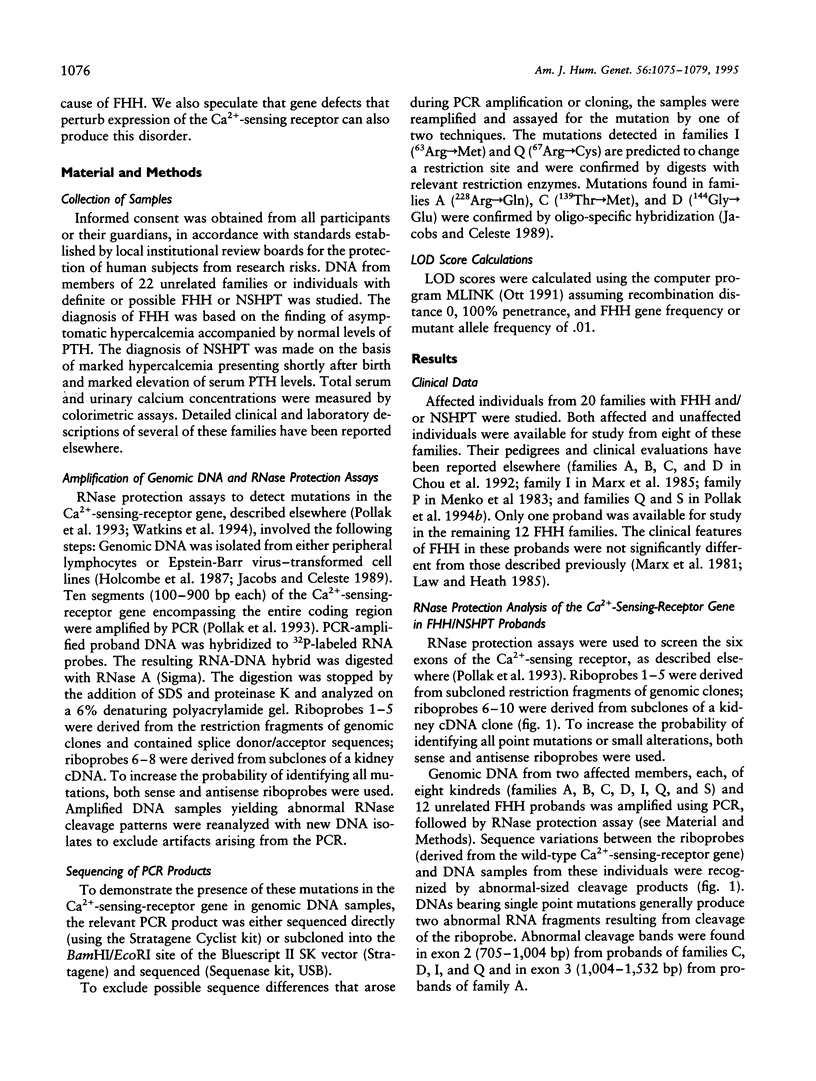
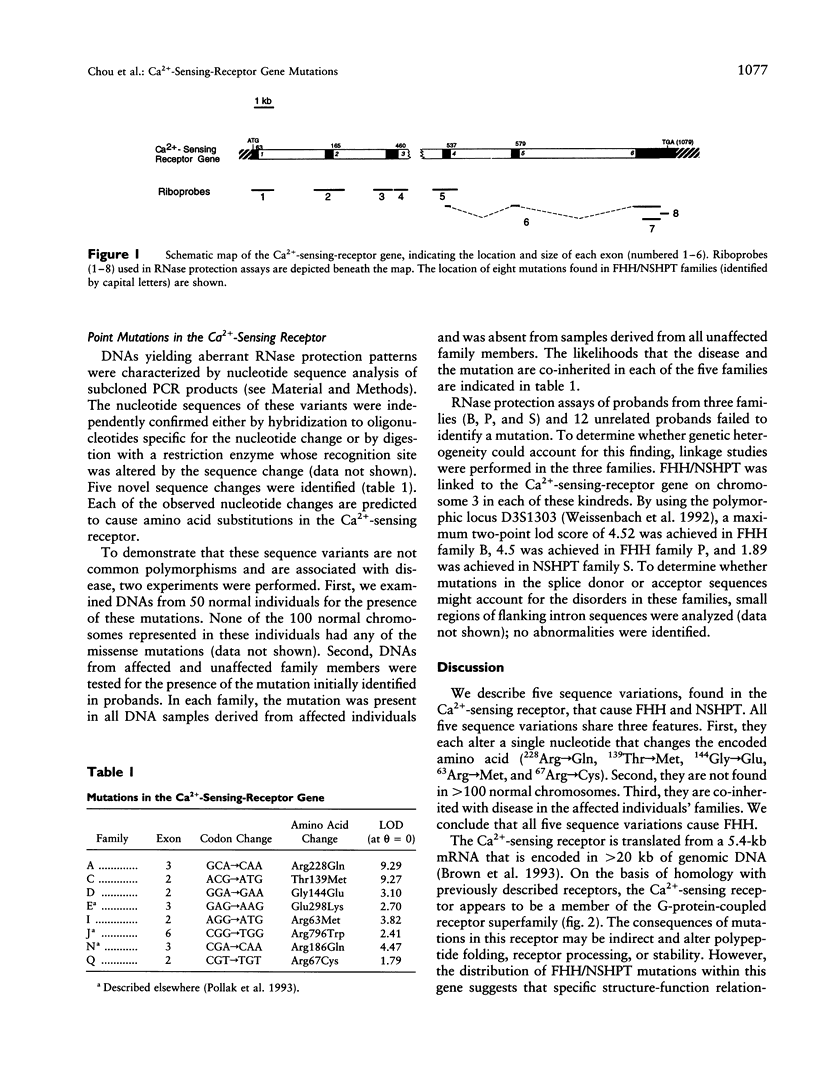
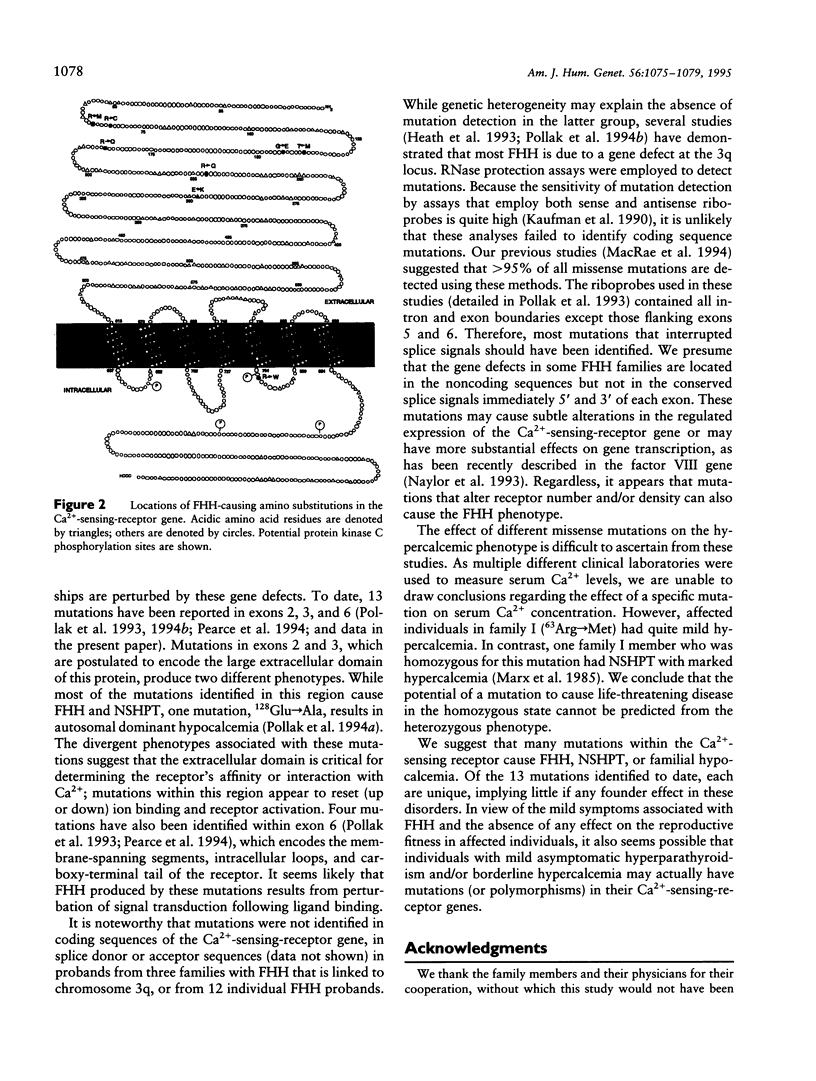
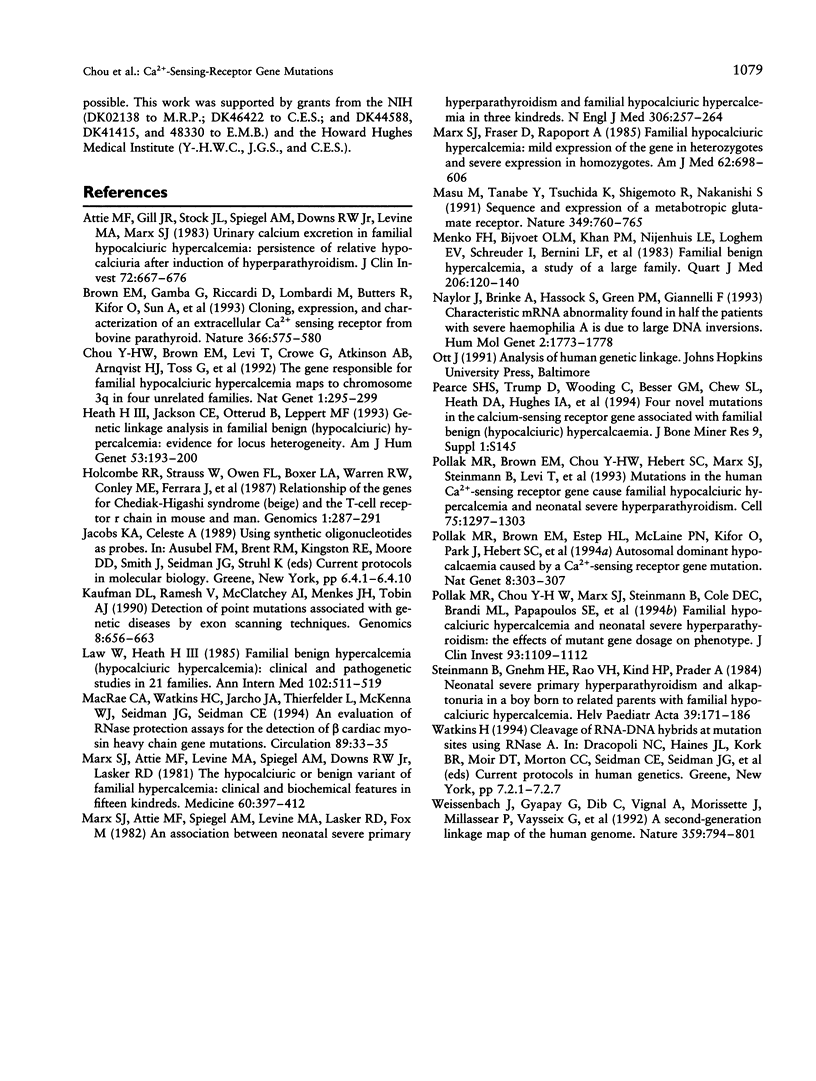
Images in this article
Selected References
These references are in PubMed. This may not be the complete list of references from this article.
- Attie M. F., Gill J. R., Jr, Stock J. L., Spiegel A. M., Downs R. W., Jr, Levine M. A., Marx S. J. Urinary calcium excretion in familial hypocalciuric hypercalcemia. Persistence of relative hypocalciuria after induction of hypoparathyroidism. J Clin Invest. 1983 Aug;72(2):667–676. doi: 10.1172/JCI111016. [DOI] [PMC free article] [PubMed] [Google Scholar]
- Brown E. M., Gamba G., Riccardi D., Lombardi M., Butters R., Kifor O., Sun A., Hediger M. A., Lytton J., Hebert S. C. Cloning and characterization of an extracellular Ca(2+)-sensing receptor from bovine parathyroid. Nature. 1993 Dec 9;366(6455):575–580. doi: 10.1038/366575a0. [DOI] [PubMed] [Google Scholar]
- Chou Y. H., Brown E. M., Levi T., Crowe G., Atkinson A. B., Arnqvist H. J., Toss G., Fuleihan G. E., Seidman J. G., Seidman C. E. The gene responsible for familial hypocalciuric hypercalcemia maps to chromosome 3q in four unrelated families. Nat Genet. 1992 Jul;1(4):295–300. doi: 10.1038/ng0792-295. [DOI] [PubMed] [Google Scholar]
- Heath H., 3rd, Jackson C. E., Otterud B., Leppert M. F. Genetic linkage analysis in familial benign (hypocalciuric) hypercalcemia: evidence for locus heterogeneity. Am J Hum Genet. 1993 Jul;53(1):193–200. [PMC free article] [PubMed] [Google Scholar]
- Holcombe R. F., Strauss W., Owen F. L., Boxer L. A., Warren R. W., Conley M. E., Ferrara J., Leavitt R. Y., Fauci A. S., Taylor B. A. Relationship of the genes for Chediak-Higashi syndrome (beige) and the T-cell receptor gamma chain in mouse and man. Genomics. 1987 Nov;1(3):287–291. doi: 10.1016/0888-7543(87)90058-9. [DOI] [PubMed] [Google Scholar]
- Kaufman D. L., Ramesh V., McClatchey A. I., Menkes J. H., Tobin A. J. Detection of point mutations associated with genetic diseases by an exon scanning technique. Genomics. 1990 Dec;8(4):656–663. doi: 10.1016/0888-7543(90)90252-p. [DOI] [PubMed] [Google Scholar]
- Law W. M., Jr, Heath H., 3rd Familial benign hypercalcemia (hypocalciuric hypercalcemia). Clinical and pathogenetic studies in 21 families. Ann Intern Med. 1985 Apr;102(4):511–519. doi: 10.7326/0003-4819-102-4-511. [DOI] [PubMed] [Google Scholar]
- MacRae C. A., Watkins H. C., Jarcho J. A., Thierfelder L., McKenna W. J., Seidman J. G., Seidman C. E. An evaluation of ribonuclease protection assays for the detection of beta-cardiac myosin heavy chain gene mutations. Circulation. 1994 Jan;89(1):33–35. doi: 10.1161/01.cir.89.1.33. [DOI] [PubMed] [Google Scholar]
- Marx S. J., Attie M. F., Levine M. A., Spiegel A. M., Downs R. W., Jr, Lasker R. D. The hypocalciuric or benign variant of familial hypercalcemia: clinical and biochemical features in fifteen kindreds. Medicine (Baltimore) 1981 Nov;60(6):397–412. doi: 10.1097/00005792-198111000-00002. [DOI] [PubMed] [Google Scholar]
- Marx S. J., Attie M. F., Spiegel A. M., Levine M. A., Lasker R. D., Fox M. An association between neonatal severe primary hyperparathyroidism and familial hypocalciuric hypercalcemia in three kindreds. N Engl J Med. 1982 Feb 4;306(5):257–264. doi: 10.1056/NEJM198202043060502. [DOI] [PubMed] [Google Scholar]
- Marx S. J., Spiegel A. M., Brown E. M., Aurbach G. D. Family studies in patients with primary parathyroid hyperplasia. Am J Med. 1977 May;62(5):698–706. doi: 10.1016/0002-9343(77)90873-7. [DOI] [PubMed] [Google Scholar]
- Masu M., Tanabe Y., Tsuchida K., Shigemoto R., Nakanishi S. Sequence and expression of a metabotropic glutamate receptor. Nature. 1991 Feb 28;349(6312):760–765. doi: 10.1038/349760a0. [DOI] [PubMed] [Google Scholar]
- Menko F. H., Bijvoet O. L., Fronen J. L., Sandler L. M., Adami S., O'Riordan J. L., Schopman W., Heynen G. Familial benign hypercalcaemia. Study of a large family. Q J Med. 1983 Spring;52(206):120–140. [PubMed] [Google Scholar]
- Naylor J., Brinke A., Hassock S., Green P. M., Giannelli F. Characteristic mRNA abnormality found in half the patients with severe haemophilia A is due to large DNA inversions. Hum Mol Genet. 1993 Nov;2(11):1773–1778. doi: 10.1093/hmg/2.11.1773. [DOI] [PubMed] [Google Scholar]
- Pollak M. R., Brown E. M., Chou Y. H., Hebert S. C., Marx S. J., Steinmann B., Levi T., Seidman C. E., Seidman J. G. Mutations in the human Ca(2+)-sensing receptor gene cause familial hypocalciuric hypercalcemia and neonatal severe hyperparathyroidism. Cell. 1993 Dec 31;75(7):1297–1303. doi: 10.1016/0092-8674(93)90617-y. [DOI] [PubMed] [Google Scholar]
- Pollak M. R., Brown E. M., Estep H. L., McLaine P. N., Kifor O., Park J., Hebert S. C., Seidman C. E., Seidman J. G. Autosomal dominant hypocalcaemia caused by a Ca(2+)-sensing receptor gene mutation. Nat Genet. 1994 Nov;8(3):303–307. doi: 10.1038/ng1194-303. [DOI] [PubMed] [Google Scholar]
- Pollak M. R., Chou Y. H., Marx S. J., Steinmann B., Cole D. E., Brandi M. L., Papapoulos S. E., Menko F. H., Hendy G. N., Brown E. M. Familial hypocalciuric hypercalcemia and neonatal severe hyperparathyroidism. Effects of mutant gene dosage on phenotype. J Clin Invest. 1994 Mar;93(3):1108–1112. doi: 10.1172/JCI117062. [DOI] [PMC free article] [PubMed] [Google Scholar]
- Steinmann B., Gnehm H. E., Rao V. H., Kind H. P., Prader A. Neonatal severe primary hyperparathyroidism and alkaptonuria in a boy born to related parents with familial hypocalciuric hypercalcemia. Helv Paediatr Acta. 1984 May;39(2):171–186. [PubMed] [Google Scholar]
- Weissenbach J., Gyapay G., Dib C., Vignal A., Morissette J., Millasseau P., Vaysseix G., Lathrop M. A second-generation linkage map of the human genome. Nature. 1992 Oct 29;359(6398):794–801. doi: 10.1038/359794a0. [DOI] [PubMed] [Google Scholar]



